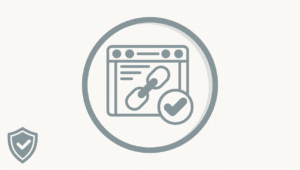Backlinks still matter, but not all links help you rank. Some links act like anchors that pull your site down. If you are chasing shortcuts, Google will notice, and the recovery will take longer than the time you saved. This guide explains the five most common risky tactics, how to spot them early, and what to do instead. Use it to protect your site, keep your link profile clean, and build authority the right way. In this article, we’ll explore the backlink blacklist and share the top 5 common tactics that will tank your Google rankings.
Why Risky Backlinks Hurt More Than They Help
Google’s goal is simple. Show searchers the most useful results. Backlinks are part of how Google measures trust and usefulness. When links look manipulative or irrelevant, the signals turn negative. You can get hit by a manual action, a sudden loss of visibility after a core update, or a slow decline as weak links outweigh strong ones. The fix is not a magic switch. It is steady cleanup, better content, and outreach that earns real references from credible sites.
Backlink Blacklist At A Glance
Use this quick table before you say yes to any link offer. If a deal checks more than one red flag, skip it and move on. Explore the backlink blacklist, common tactics that tank Google rankings.
| Tactic | What It Looks Like | Why It Tanks Rankings | Red Flags To Spot | Safer Alternative |
|---|---|---|---|---|
| Paid Link Packages | Bundles that promise hundreds of links for a flat fee | Low quality networks trigger spam signals and manual actions | Guaranteed placements, exact match anchors on every link, irrelevant sites | Earned coverage through digital PR and targeted guest features with full disclosure |
| Private Blog Networks | Dozens of sites with thin content and recycled designs | Footprints reveal common ownership which devalues all links | Same IP ranges, same themes, identical author bios, spun posts | Pitch niche publishers and associations, build topical resources people want to cite |
| Mass Link Exchanges | You link to me and I link back in bulk | Reciprocal patterns reduce trust and can suppress value | Site-wide blogrolls, templated swap emails, link wheels | Limited and relevant partnerships with clear editorial barriers |
| Comment And Forum Spam | Links dropped in threads with no context | Low authority pages and user generated spam create noise not trust | Generic comments, profiles with zero history, no moderation | Thoughtful participation, helpful answers, and profile links that add context without anchor stuffing |
| Automated Directories And Web 2.0 Dumps | Hundreds of thin profiles and brand pages | Duplicate descriptions and empty shells add no value | Exact duplicate bios, dead categories, aggressive upsells | Claim a few quality profiles and invest in listings that real customers use |
Tactic One Paid Link Packages
If a service promises fast links on any topic, you are buying access to a network. Networks leave patterns. The same site shells, the same outbound anchor styles, the same categories that accept anything. A few of these links may slip through, but the net effect is negative. You also lose control of context, which matters for ranking. Links should point from relevant pages to relevant pages with a reason to exist.
What to do instead. Build a short list of pages that deserve attention. Create a small data point, a checklist, or a visual that helps your industry. Pitch it to editors who cover that exact topic. If you do sponsor a placement, treat it as advertising and label it. Use a nofollow or sponsored attribute and aim for referral traffic, not ranking gains.
Tactic Two Private Blog Networks
PBNs often look convincing at first glance. The domains once had real content. The metrics may look decent. Look closer and you will see thin posts, recycled stock photos, vague author names, and syndicated filler. The goal of a PBN is to pass PageRank, not to serve readers. Once a network gets flagged, everything attached to it weakens.
What to do instead. Publish content that answers specific questions with evidence. Then do one of these three things. Pitch a unique angle to a trade publication, contribute a practical guide to a partner’s blog, or support a small survey and share the results with journalists who cover your beat. Fewer links from the right places are worth far more than a pile of network links.
Tactic Three Mass Link Exchanges
Trading links occasionally between peers happens in healthy ecosystems. The problem starts when every new relationship becomes a swap. Circular linking turns into a pattern. Patterns are easy to identify at scale and they reduce trust. If your outreach includes the phrase let us exchange links on multiple sites, you are building a footprint that will age badly.
What to do instead. Keep a simple rule. Earned first, reciprocated later and only when useful for readers. If you run a partner directory or a resources page, set clear criteria for inclusion. Disclose relationships. Vary anchor text. Link where it helps users, not where it flatters metrics. Continue reading to understand the backlink blacklist, common tactics that tank Google rankings.
Tactic Four Comment And Forum Spam: Backlink Blacklist
Dropping links into random comments used to move the needle. Today it invites filters and hurts your brand reputation. Most modern platforms mark user links as nofollow or UGC anyway. You still can use communities to build awareness, but do it with intent. Answer questions thoroughly, link to source documents, and mention your piece only when it provides the missing detail. Consider how the thread will read a year from now. If the link feels like an interruption, do not add it.
What to do instead. Build a contributor profile on one or two active communities in your niche. So, present in the backlink blacklist, common tactics that tank Google rankings. Post helpful replies, cite neutral resources, and link to your own work sparingly. The goal is to be recognized as a useful voice. That recognition tends to produce invitations that lead to real editorial links.
Tactic Five Automated Directories And Web 2.0 Dumps
There are a few directories that users rely on. There are thousands that exist only to sell listings. The difference shows up in traffic, brand recognition, and editorial standards. Automated tools that create hundreds of profiles with the same description do not create authority. They create clutter. Google can see identical text across thin pages and will devalue it.
What to do instead. Claim important branded profiles, then move on. Spend the remaining time on assets that earn citations. Examples include industry glossaries, short checklists, side by side comparisons, or public templates. Journalists and bloggers link to resources that save them time.
How To Audit Your Link Profile In One Hour
You do not need expensive software to run a first pass. Start with your top ranking pages and your most important sales pages.
Export referring domains from your preferred tool, or use Search Console’s linking report. Sort by domain authority, traffic estimates, and topical relevance. Flag anything that sits far outside your niche, uses aggressive anchors, or comes from a site with thin content and obvious ads above the fold.
Create three buckets. Keep, review, remove. Keep contains editorial links from relevant articles. Review contains odd matches that might still be fine. Remove contains clear spam, paid networks, and automated junk.
For remove, collect URLs and domains and prepare a disavow file. For review, visit each page and decide with a second set of eyes. If a link looks like it exists only to manipulate rankings, treat it like a remove. So it’s on the backlink blacklist, common tactics that tank Google rankings.
How To Recover From A Bad Link Portfolio: Backlink Blacklist
Recovery is not instant, but it is repeatable. Publish something genuinely useful every two weeks and promote it to a short list of writers who would care. Clean up internal links so your best content supports your important pages. Submit a disavow file for domains and URLs you cannot get removed. Document your cleanup effort in case you ever need to request reconsideration. Track organic clicks to target pages and the number of unique referring domains. The slope matters more than the absolute count.
Use this simple cadence. Audit monthly, pitch weekly, publish biweekly. After two to three months you should see stability return, followed by gradual growth as new, relevant links begin to compound.
Anchor Text Choices That Keep You Safe
Exact match anchors look unnatural in bulk. Natural anchors look like how people talk. Aim for brand, page titles, and descriptive phrases that fit the sentence. Encourage publishers to write in their own voice. Never send a fixed anchor list. If a publisher asks for one, provide several natural variants and suggest that they pick what feels right for their readers.
Outreach That Earns Links Without Raising Flags
Editors and site owners care about their readers. If your pitch helps their audience, they will consider it. Keep your message short. Present a clear idea in two or three sentences. Offer a quote, a chart, or a tiny dataset that simplifies a story they already want to cover. Reference a recent article and explain how your contribution builds on it. If you have genuine expertise, say so with one sentence and a proof point. Follow up once, then move on.
Measuring Link Quality With Simple Signals
You do not need a dozen metrics. Pick four that reflect reality. Relevance of the linking page to your topic. Actual traffic to the page or site. Placement within the main content rather than footers or sidebars. Context that explains why your page deserves the mention. When these four are present, the link will likely help, even if the domain is not famous. When they are missing, the link is likely to hurt, even if a tool shows a high score.
Frequently Asked Questions Backlink Blacklist
Can I Use A Small Number Of Paid Placements If They Are Relevant
Paid placements are advertising, not signals of editorial trust. If you buy them, label them and use the sponsored attribute. Treat them as a way to reach readers, not to pass PageRank.
Do I Need To Disavow Every Suspicious Link
Focus on clear spam and manipulative patterns. Google claims to ignore many low quality links. Use disavow when you see a cluster of harmful domains or when a manual action is present.
How Many Guest Posts Are Safe
Guest posts are fine when they provide genuine value and the host edits for quality. Problems arise when you churn out templated articles only to place links. Quality first, frequency second.
A Simple Weekly Checklist To Keep You Honest
Use this five point checklist every Friday afternoon. It keeps your program clean and compounding.
- Review new links for relevance and context.
- Scan anchors for natural language.
- Add one new pitch to your outreach list.
- Identify one resource to update or expand.
- Log spammy referrals and prepare your next cleanup batch.
Consistency wins. If you avoid the five tactics in this blacklist and keep shipping useful resources, your rankings will improve without the risk of a crash.
Backlink Blacklist Bonus Comparison Table For Quick Decisions
Use this second table when you evaluate any link opportunity. Score one point for each item present. Three or more points means decline without regret.
| Checkpoint | Safe Indicator | Risk Indicator |
|---|---|---|
| Editorial Control | Edited, original article with clear byline | No edits, instant publish promise |
| Context | Natural mention within body copy | Footer or author box link only |
| Relevance | Same topic or adjacent topic | Off topic site with random categories |
| Traffic | Page gets real visits from search or social | Zero traffic, no indexable history |
| Anchor Text | Descriptive phrase or brand | Repeated exact match keyword |
| Link Type | Followed when editorial, nofollow when sponsored | Forced followed links for any placement |
| History | Site publishes useful articles for humans | Site sells placements on a pricing page |
Make this framework a habit. Over time you will spend less time worrying about penalties and more time building work that others want to reference.






